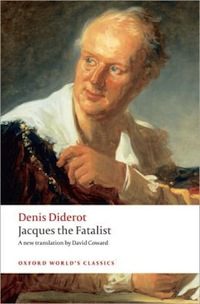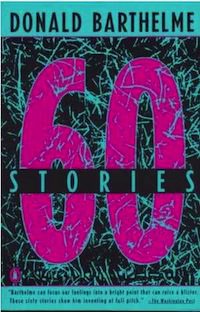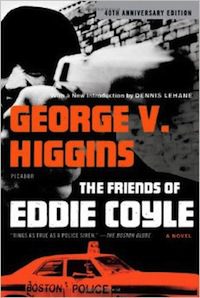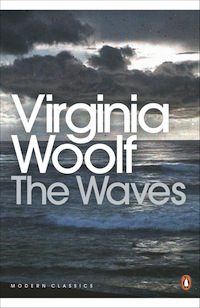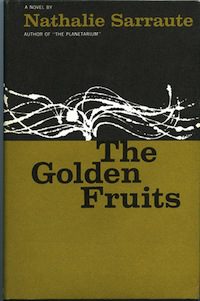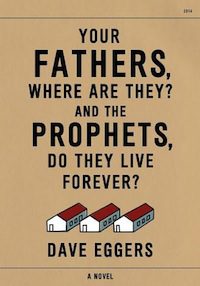
The dialogue novel is a unique creature. In it the conversations among characters are the primary or only means of narrative advancement—so the initial experience might be similar to reading a play or movie script, where we’re tasked to mentally dramatize what we’re reading. But the dialogue novel is intriguing because it is not meant for stage or screen. And compared to its compatriot, the monologue novel—which has a substantial history shaped by Dostoevsky, Nabokov, and W.G. Sebald, to name only three masters of that form—the dialogue novel is quite rare. While they can be challenging to read, dialogue-dominated narratives create amazing opportunities for philosophical inquiry, stylistic originality, and stunning creativity that are surely worth exploring.
With the release of Dave Eggers’s Your Fathers, Where Are They? And The Prophets, Do They Live For Ever?, there’s been a bit of buzz about all the talking in the novel. Eggers’s tale is told entirely through dialogue, without a single physical description or psychological detail to guide us. Thomas, a slightly unhinged guy in his thirties, is holding an astronaut, a retired Congressman, and his mother, along with a few other people, captive in an abandoned military base and is questioning them about why the world is the way it is. In a negative review for the New York Times, Michiko Kakutani called this Q&A format “a straightjacket that prevents Mr. Eggers from exercising his virtuosic powers of description.” It’s not surprising that some readers may be off-put by this constricted approach to storytelling. But this constraint has been employed to perfection by a diverse array of writers, including Diderot, Donald Barthelme, David Foster Wallace, Lauren Myracle, and Thomas King.
*
Inquiry through Interlocution – Diderot, Donald Barthelme, and David Foster Wallace
The dialogue novel is often deeply intellectual. Recalling the conversations of Socrates and Plato, it allows for freewheeling philosophical inquiry. The lack of solidified characters and settings engenders abstraction, an open space where jokes, digressions, and ideas can roam wild. Diderot’s Jacques the Fatalist and his Master, first published in France in 1796, tells of chummy Jacques and his humdrum master. To pass the time on their journey, Jacques regales his master with tales of love and loss. Regardless of what happens—whether it’s tragic, banal, absurd, or romantic—Jacques claims it was written up above, meaning everything is predetermined, meaning that the course of our lives was set before we ever got here, which raises questions about the deterministic nature of existence, among other things. Overlapping this conversation is the one the Narrator has with you—that constant source of annoyance and distraction, the Reader. “But if you keep on interrupting me, Reader, and if I interrupt myself all the time, what will become of Jacques’s loves?” the Narrator chides us.
Milan Kundera calls Jacques the Fatalist and his Master a grand game and masterpiece of 18th-century literature, reaching “heights of playfulness, of lightness, never scaled before or since.” The dialogue bounces back and forth, with nested stories, sampled anecdotes, and sly asides. At one point, Jacques reminds his master:
Can’t you see that as soon as I open my mouth on the subject the devil interferes and something always happens which cuts me off? I’ll never finish it, I tell you. That is written up above.
The structure of this novel allows for philosophical questions about the nature of narrative itself. We’re asked to participate in the conversation, a twisted polyphony that irritates, inspires, and delights us. Using dialogue extensively, Diderot created one of the most intriguing, intellectually fascinating works of fiction ever written.
In numerous dialogue-only stories, Donald Barthelme uses a similar bouncing back-and-forth style to explore philosophical conundrums. In “The Leap,” two characters chat about life and prepare to make a Kierkegaardian “leap to faith.” Although we never learn the characters’ names, we get a sense of what’s at stake for them, of the mysteries they’re trying to puzzle out—about God, creativity, death, and plant life. Another recent example of this digressive philosophical inquiry occurs in Infinite Jest, where one of the three main plots is a conversation between a member of the Assassins des Fauteuils Rollents and a representative of the U.S. government. On the outskirts of Tucson, they talk about war, love, fanaticism, freedom, and America the delusional. It’s a format that allows Wallace to directly address political and philosophical questions in an immediate, hilarious manner.
Barthelme and Wallace successfully blend rambunctious chatter with serious intellectual searching. Their characters can be philosophers and jesters simultaneously. But while Eggers introduces some worthwhile questions in Your Fathers, Where Are They?, there is little depth to his inquiries. One challenge is that Eggers’s central character, Thomas, is too much a trope of popular culture. He’s that contemporary dullard, the bland, irate, suburban white guy. When he asks, “Have you ever had that, where you’re lying there, and the questions are these asps wrapping themselves around your throat?” there is little to interest or invest us in his personal struggles. Eggers fails to characterize Thomas, to make him fully realized and rounded, and he fails to delve deeply enough into the philosophical questions that underpin contemporary American society, which leaves the inquiry here lacking. But for more quick-witted and surefooted writers, dialogue-driven narratives can offer amazing opportunities to explore the most pressing and random questions about our lives.
*
Elimination and Excess – George V. Higgins, Lauren Myracle, and Ernest Hemingway
Traditional stories are a balanced mix of dialogue, description, exposition, and psychological insight. When a writer chooses to eliminate one (or some) of these four modes of storytelling, the remaining mode(s) must be pursued to excess. With a dialogue-driven novel, there are no other means through which to advance the story, except through talk. This leads to some interesting novels that ask us to step back and acknowledge the uncreative operations that appear almost automatically in more traditional tales.
Although only about 65% dialogue, the 1970 crime classic The Friends of Eddie Coyle is fueled by terse exchanges that ricochet off the page and are occasionally punctuated with violence. By using dialogue to propel his plot, George V. Higgins is able to create a story that crackles with linguistic originality. He avoids many of the clichés we find in realistic writing—the bland descriptions, tedious scene setting, and emoticon-like pauses that pace conversations (e.g. “He frowned.” / “Her nose became red with rage.”). Higgins knows precisely where to cut into and out of characters’ exchanges, so there is a non-stop momentum—the talk comes so quick we can barely catch our breath before the next barrage of banter. Instead of using dialogue to merely add color or voice to a scene, Higgins relies on it to accomplish everything, creating an intertwined adventure that veers this-way-and-that, careening from one brutality to the next.
At the other end of the dramatic spectrum is ttyl, Lauren Myracle’s 2004 YA novel told entirely through the instant messages of SnowAngel, mad maddie, and zoegirl (Angela, Maddie, and Zoe, respectively)—messages that can be understood as electronic dialogue. Every day the girls gab after school, typing it up, sharing thoughts and planning their next social maneuvers. The world outside their chats is vibrant and kinetic, bursting with teenage drama and outrageous slights. Every new messaging exchange has two responsibilities: to fill-in us in on what’s just happened and to set into motion what will happen next. What makes this structure so fascinating are the gaps between the chats. We only get the recaps, the girls’ versions of events as told their friends, so we must analyze the stories that the characters craft and parse out the deeper meanings to understand what’s going on.
Hemingway’s “Hills Like White Elephant” operates in a similar fashion. It’s not until we’re halfway through the story that we learn what’s really at stake. At first, the “American and the girl with him” talk about their drinks and the landscape and it all seems commonplace, even banal. But when the man says, “It’s really a simple operation, Jig,” we realize something else is being discussed. By excluding the backstory and disavowing psychological descriptions, Hemingway forces us to listen so closely to his characters, to really hear them, that he takes the dialogue-driven narrative to a place of extreme emotional depth that would not be possible with a more traditional style.
*
From Constraint To Creativity – A.B. Yehoshua, Nathalie Saurrate, Virginia Woolf, William Gaddis, Italo Calvino, and Thomas King
Perhaps the strangest dialogue novel in recent memory is Mr. Mani by Israeli writer A.B. Yehoshua. It consists of five one-sided conversations. We hear only half of what is being said. It is a very tight constraint, but Yehoshua—through sheer force and clarity of vision—employs it masterfully to engage us with primal dramas about life and death. In the third conversation, set in Jerusalem during World War I, a young Jewish prosecutor in the British army discusses the case of a political agitator with his superior:
— … That’s why the prosecution will have to ask for the death penalty, since he’s a national who has betrayed his country . . . which is why I’ve come to you, Colonel, to ask your advice before the trial begins.
—Of course, sir. Pardon me.
—Quite, sir, quite, it was my mistake to jump ahead. I simply didn’t want to bore you with all kinds of details that I myself find endlessly fascinating.
Slowly, we learn the details of the case: Joseph Mani, a British national born to Jewish parents, has tried to awaken the political consciousness of the people of Palestine and committed numerous acts of treason against Great Britain. Through this one-sided conversation, Yehoshua explores the cultural milieu of Jerusalem around the turn-of-the-century and looks toward the imperialist ramifications of World War I. This specific constraint places a fascinating burden on us, the readers, as we must constantly imagine what has been left out. Thus we become participants in the dramatic discourse.
Without a doubt, a novel composed entirely or primarily of dialogue is a challenge to even the most willful of readers. But this refusal to use a more traditional approach to storytelling, this rejection of exposition, description, and psychological insights, can lead to astounding creativity, as in the case of Mr. Mani or The Golden Fruits by Nathalie Sarraute or The Waves by Virginia Woolf. Such a constraint is also behind one of the most challenging and rich American novels ever written—J R. William Gaddis’s second novel is an indomitable book, told almost entirely through dialogue. In it, Gaddis delves into the madness and mania of contemporary life and satirizes the very foundation of the American dream. It’s Lydia Millet’s favorite novel.
Then there are the creative masterpieces that blend dialogue with other forms of oral storytelling. In Italo Calvino’s Invisible Cities, Marco Polo and Genghis Khan serenade each other with delightful visions of fantastical cosmopolises. Calvino introduces a fairytale element here—with Polo and Khan trading visions of the wondrous cities that exist only in the outermost regions of our imaginations. In Green Grass, Running Water, Thomas King draws on the oral tradition—in particular, the power of origin stories—to propel his narrative and integrate a plethora of cultural spokespeople, including Coyote, the Lone Ranger, and a TV salesman. In all of these dialogue-driven narratives, the authors are able to write incredibly complex, incredibly creative stories not in spite of, but because of, this constraint.
Of course there are failures. Although Eggers’s new novel never attains the intellectual, stylistic, and creative achievements seen in these other examples, it is a still worth taking a gander at. It’s by no means the worst dialogue novel—that distinction goes to Deception by Philip Roth, which is the weakest book out of the forty-plus that he’s written. Here Roth is unable to create a story of meaningful depth. His characters’ banter is merely blather about the typical Rothian themes. The book is blatant and undemanding; it fails to involve us as readers and therefore feels trite and tossed-off.
Dialogue novels and stories are worth reading not simply because of their unique structures, but because of how they engage us. We must become active readers and listeners. We must work to understand the characters’ perspectives and hear the real stories beneath the ones they’re telling. These dialogue novels and stories ask us to rethink conversations both in fiction and in life and to realize that the simple act of speaking, of talking to one other, is more than enough to convey even the most complex adventures.

